Manganese-Enhanced Magnetic Resonance Imaging Enables In Vivo Confirmation of Peri-Infarct Restoration Following Stem Cell Therapy in a Porcine Ischemia-Reperfusion Model
- PMID: 26215972
- PMCID: PMC4608088
- DOI: 10.1161/JAHA.115.002044
Manganese-Enhanced Magnetic Resonance Imaging Enables In Vivo Confirmation of Peri-Infarct Restoration Following Stem Cell Therapy in a Porcine Ischemia-Reperfusion Model
Abstract
Background: The exact mechanism of stem cell therapy in augmenting the function of ischemic cardiomyopathy is unclear. In this study, we hypothesized that increased viability of the peri-infarct region (PIR) produces restorative benefits after stem cell engraftment. A novel multimodality imaging approach simultaneously assessed myocardial viability (manganese-enhanced magnetic resonance imaging [MEMRI]), myocardial scar (delayed gadolinium enhancement MRI), and transplanted stem cell engraftment (positron emission tomography reporter gene) in the injured porcine hearts.
Methods and results: Twelve adult swine underwent ischemia-reperfusion injury. Digital subtraction of MEMRI-negative myocardium (intrainfarct region) from delayed gadolinium enhancement MRI-positive myocardium (PIR and intrainfarct region) clearly delineated the PIR in which the MEMRI-positive signal reflected PIR viability. Human amniotic mesenchymal stem cells (hAMSCs) represent a unique population of immunomodulatory mesodermal stem cells that restored the murine PIR. Immediately following hAMSC delivery, MEMRI demonstrated an increased PIR viability signal compared with control. Direct PIR viability remained higher in hAMSC-treated hearts for >6 weeks. Increased PIR viability correlated with improved regional contractility, left ventricular ejection fraction, infarct size, and hAMSC engraftment, as confirmed by immunocytochemistry. Increased MEMRI and positron emission tomography reporter gene signal in the intrainfarct region and the PIR correlated with sustained functional augmentation (global and regional) within the hAMSC group (mean change, left ventricular ejection fraction: hAMSC 85±60%, control 8±10%; P<0.05) and reduced chamber dilatation (left ventricular end-diastole volume increase: hAMSC 24±8%, control 110±30%; P<0.05).
Conclusions: The positron emission tomography reporter gene signal of hAMSC engraftment correlates with the improved MEMRI signal in the PIR. The increased MEMRI signal represents PIR viability and the restorative potential of the injured heart. This in vivo multimodality imaging platform represents a novel, real-time method of tracking PIR viability and stem cell engraftment while providing a mechanistic explanation of the therapeutic efficacy of cardiovascular stem cells.
Keywords: ischemia–reperfusion injury; magnetic resonance imaging; manganese‐enhanced magnetic resonance imaging; peri‐infarct region imaging; stem cell imaging.
© 2015 The Authors. Published on behalf of the American Heart Association, Inc., by Wiley Blackwell.
Figures




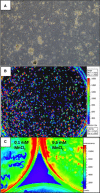
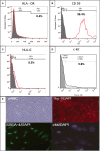

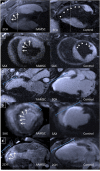
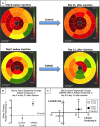
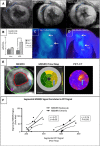
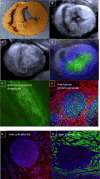
Similar articles
-
Telmisartan in the diabetic murine model of acute myocardial infarction: dual contrast manganese-enhanced and delayed enhancement MRI evaluation of the peri-infarct region.Cardiovasc Diabetol. 2016 Feb 5;15:24. doi: 10.1186/s12933-016-0348-y. Cardiovasc Diabetol. 2016. PMID: 26846539 Free PMC article.
-
Direct evaluation of myocardial viability and stem cell engraftment demonstrates salvage of the injured myocardium.Circ Res. 2015 Mar 27;116(7):e40-50. doi: 10.1161/CIRCRESAHA.116.304668. Epub 2015 Feb 5. Circ Res. 2015. PMID: 25654979 Free PMC article.
-
Myocardial viability of the peri-infarct region measured by T1 mapping post manganese-enhanced MRI correlates with LV dysfunction.Int J Cardiol. 2019 Apr 15;281:8-14. doi: 10.1016/j.ijcard.2019.01.101. Epub 2019 Jan 31. Int J Cardiol. 2019. PMID: 30739802 Free PMC article.
-
Diagnostic and prognostic value of cardiac magnetic resonance imaging in assessing myocardial viability.Top Magn Reson Imaging. 2008 Feb;19(1):15-24. doi: 10.1097/RMR.0B013e31817d550c. Top Magn Reson Imaging. 2008. PMID: 18690157 Review.
-
[Magnetic resonance tomography imaging techniques for diagnosing myocardial vitality].Herz. 1994 Feb;19(1):51-64. Herz. 1994. PMID: 8150414 Review. German.
Cited by
-
Angiogenic stem cell delivery platform to augment post-infarction neovasculature and reverse ventricular remodeling.Sci Rep. 2022 Oct 20;12(1):17605. doi: 10.1038/s41598-022-21510-y. Sci Rep. 2022. PMID: 36266453 Free PMC article.
-
Diffusion Tensor CMR: A Novel Approach for Evaluation of Myocardial Regeneration.JACC Basic Transl Sci. 2018 Mar 1;3(1):110-113. doi: 10.1016/j.jacbts.2018.01.008. eCollection 2018 Feb. JACC Basic Transl Sci. 2018. PMID: 30062197 Free PMC article.
-
Induced Pluripotent Stem Cell (iPSC)-Derived Exosomes for Precision Medicine in Heart Failure.Circ Res. 2018 Mar 2;122(5):661-663. doi: 10.1161/CIRCRESAHA.118.312657. Circ Res. 2018. PMID: 29496797 Free PMC article. Review. No abstract available.
-
A rapid T1 mapping method for assessment of murine kidney viability using dynamic manganese-enhanced magnetic resonance imaging.Magn Reson Med. 2018 Jul;80(1):190-199. doi: 10.1002/mrm.27025. Epub 2017 Nov 28. Magn Reson Med. 2018. PMID: 29193339 Free PMC article.
-
Quantitative Efficacy and Fate of Mesenchymal Stromal Cells Targeted to Cardiac Sites by Radiofrequency Catheter Ablation.Cell Transplant. 2020 Jan-Dec;29:963689720914236. doi: 10.1177/0963689720914236. Cell Transplant. 2020. PMID: 32207339 Free PMC article.
References
-
- Lloyd-Jones D, Adams R, Carnethon M, De Simone G, Ferguson TB, Flegal K, Ford E, Furie K, Go A, Greenlund K, Haase N, Hailpern S, Ho M, Howard V, Kissela B, Kittner S, Lackland D, Lisabeth L, Marelli A, McDermott M, Meigs J, Mozaffarian D, Nichol G, O’Donnell C, Roger V, Rosamond W, Sacco R, Sorlie P, Stafford R, Steinberger J, Thom T, Wasserthiel-Smoller S, Wong N, Wylie-Rosett J, Hong Y. Heart disease and stroke statistics—2009 update: a report from the American Heart Association Statistics Committee and Stroke Statistics Subcommittee. Circulation. 2009;119:480–486. - PubMed
-
- Heidary S, Patel H, Chung J, Yokota H, Gupta SN, Bennett MV, Katikireddy C, Nguyen P, Pauly JM, Terashima M, McConnell MV, Yang PC. Quantitative tissue characterization of infarct core and border zone in patients with ischemic cardiomyopathy by magnetic resonance is associated with future cardiovascular events. J Am Coll Cardiol. 2010;55:2762–2768. - PubMed
-
- Tsukiji M, Nguyen P, Narayan G, Hellinger J, Chan F, Herfkens R, Pauly JM, McConnell MV, Yang PC. Peri-infarct ischemia determined by cardiovascular magnetic resonance evaluation of myocardial viability and stress perfusion predicts future cardiovascular events in patients with severe ischemic cardiomyopathy. J Cardiovasc Magn Reson. 2006;8:773–779. - PubMed
-
- Jaussaud J, Biais M, Calderon J, Chevaleyre J, Duchez P, Ivanovic Z, Couffinhal T, Barandon L. Hypoxia-preconditioned mesenchymal stromal cells improve cardiac function in a swine model of chronic myocardial ischaemia. Eur J Cardiothorac Surg. 2012;43:1050–1057. - PubMed
-
- Kawamura M, Miyagawa S, Miki K, Saito A, Fukushima S, Higuchi T, Kawamura T, Kuratani T, Daimon T, Shimizu T, Okano T, Sawa Y. Feasibility, safety, and therapeutic efficacy of human induced pluripotent stem cell-derived cardiomyocyte sheets in a porcine ischemic cardiomyopathy model. Circulation. 2012;126:S29–S37. - PubMed
Publication types
MeSH terms
Substances
Grants and funding
LinkOut - more resources
Full Text Sources
Medical

